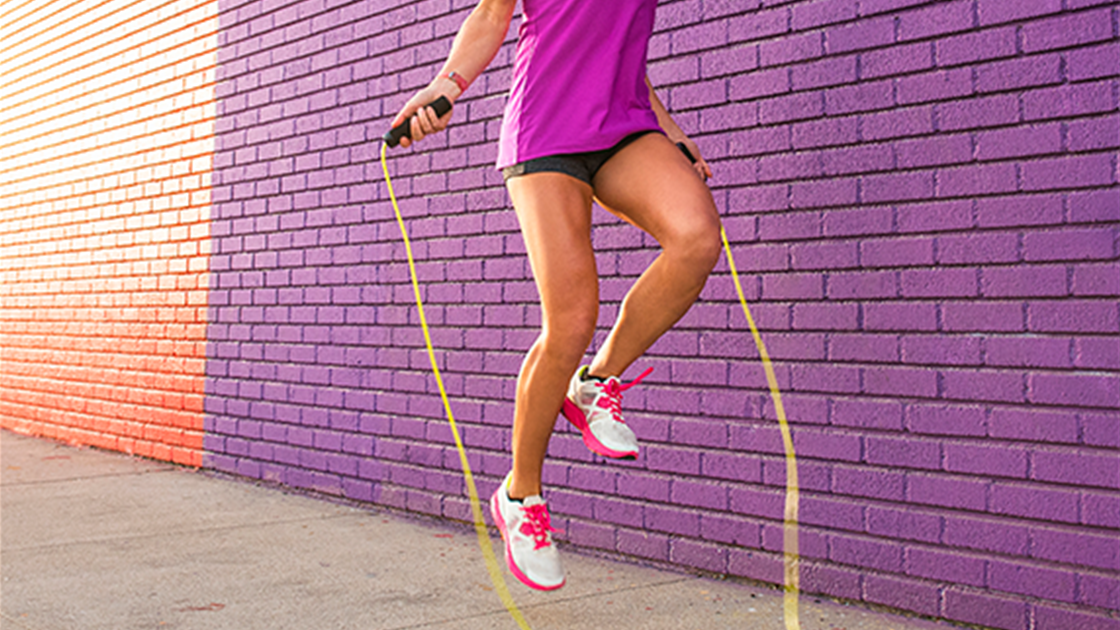Skipping is one of those exercises you probably got really into as a child, and then promptly forgot about when you got older. But skipping isn’t just for kids—it’s a great workout that you can do at any age.
Many gyms will have at least one skipping rope hanging around, and several celebrities—including Kaley Cuoco and Jennifer Garner—have shared videos on Instagram of themselves showing off some impressive jump roping skills.
View this post on Instagram
Skipping allows you get in a good cardio workout while also working on lower-body strength training, says dietitian and exercise expert Albert Matheny. You can make your legs burn, torch kilojoules, and get all sweaty, just by using something you considered a toy as a kid, he points out.
But skipping is also easily accessible, given that most people can shell out a few dollars for a rope. It also doesn’t require any fancy equipment or training to perfect your technique.
And, while a skipping rope doesn’t look like much, it’s surprisingly versatile, allowing you do to a range of exercises from running jumps to HIIT workouts, Matheny says.
But one of the biggest perks of skipping—especially these days—is that you can easily do it at home. That’s a huge pro at a time when plenty of people are still wary of going to the gym.
“Pretty much anybody can skip,” says Dr Irvin Sulapas, a sports medicine specialist. However, he adds, anyone with ongoing lower joint issues should hold off. Doug Sklar, a certified personal trainer agrees. “Anyone with healthy joints can give it a try,” he says.
Want to get into skipping? Here’s how to get started—and why it’s so good for you.
How to skip
While many people picked this up as a kid, not everyone was once an avid skipper. Here’s how to skip, per Matheny:
- Hold the end of a skipping rope in each hand, with the rope’s loop resting on the ground behind you.
- Swing the rope over your head and around your body.
- Jump as it passes under your feet.
- Repeat.
Note: You can also skip backwards, but most people prefer to see the rope as it comes over their head to lower the risk of tripping.
What’s the best skipping form?
“It starts with a properly-sized rope,” Sklar says. “Standing on the center of the rope, the end of the rope should be at armpit height.” Pro tip: If your skipping rope is too long, you can add knots underneath the handles to adjust the length.
When actually skipping, you’ll want to have your knees slightly bend, with your upper arms close to your ribs, he says. “Most of the movement should come from the wrists with minimal elbow and shoulder movement,” Sklar advises. “Avoid making large arm circles.”
After you jump, “land on the balls of your feet and keep your knees slightly bent,” Matheny says. This, he explains, “helps absorb some of the impact of landing.”
The benefits of skipping
There are a lot of potential benefits of skipping, but experts say these are the biggies:
It makes working out fun.
Skipping is naturally associated with childhood and that innately can make it feel fun and different from logging time on a treadmill or bike, Sklar says. “Skipping creates a challenge for kids and adults alike,” he says. “Once you've mastered the basics, there are always new challenges and ways to get creative.”
It gets your heart rate up quickly.
Skipping is a high-intensity activity, Dr Sulapas points out—and that can cause your heart rate to jump up quickly. “Your whole body is involved,” Sklar says, “so once you get moving, your heart has to work hard to keep you going.”
It’s easy cardio.
Skipping gives you a lot of bang for your cardio buck. “If you’re skipping at any speed for 30 seconds, you’re going to start to feel it,” Matheny says. “There’s a lot of coordination between different muscle groups.”
Worth noting: Skipping can actually cut down on the overall amount of time you have to log for a workout to stay healthy. Vigorous exercises like skipping is about twice as efficient as moderate-intensity activities. So, if your main form of exercise is skipping, you technically only need to log 75 minutes of workouts a week (along with muscle-strengthening exercises) compared to something more moderate, like brisk walking.
It builds bone density.
There are a few things that jumping rope does to help build your bone density. “Skipping helps strengthen the bone density by strengthening the muscles around the bones, specifically the legs,” Dr. Sulapas says. “Building stronger muscles, in turn, helps build stronger bones in general, and jump roping can do that.” But the actual impact that comes from jumping (or, more specifically, landing) also helps strengthen your bones, Matheny says. “Your body in any area responds to stress,” he explains. “If you’re putting small amounts stress on your bones, they will become more resilient and either build the density, if you’re younger, or help you maintain it, if you’re older.”
Why does this matter? It can help lower your risk of developing conditions like osteoporosis as you age.
It can be an efficient warm-up.
Like the idea of skipping but aren’t sold on it being the main event? “It can serve as a warm-up,” says personal trainer, Judith Deutsch PhD.
She points to a “really interesting” study published in the International Journal of Sports Physiology and Performance that had 96 endurance runners either replace five minutes of their usual warm-up with skipping or keep it the same. After 10 weeks, the researchers found that the skipping group had double the increase in 3K time trial performance than the control group.
It’s really versatile.
Matheny points out that you only get as much out of skipping as you put into it—and you can build on it as you get better and more experienced with it. “It’s good to make these workouts goal-based,” he says. “If you’re new, that can mean hitting a certain number of jumps in a row.” You can also do workouts with 30 seconds on and 30 seconds off, along with including skipping in circuit training workouts, he says. “It’s a great thing to throw into your fitness routine,” Matheny adds.
It’s easy to do when you travel.
Sklar calls a skipping rope “one of the easiest pieces of exercise equipment to take on holidays because of the small size, light weight, and portability.” Once you get to your destination, you can either skip in the place where you’re staying or take it outside for an outdoor workout, Matheny says. “It’s so portable,” he adds.
It improves coordination and agility.
You have to pay attention when you skip and learning to jump over that rope in time with the rhythm you have going on will improve your coordination and agility, Dr Sulapas says. “Jump roping takes a lot of coordination in a rhythmic cadence,” he says. “Jumping over a rope in a repetitive pattern can improve footwork patterns and overall hand-eye coordination.”
It helps with balance.
You have to be able to stay upright when skip and keep your core fairly strong, Matheny says. You also need to keep your balance in check between each jump, he points out. As a result, it helps improve your overall balance.
It gives you more explosive power.
Skipping—especially at faster speeds—is all about explosive power, Matheny says. That is, the ability to quickly jump up, recover, and do it again. Perfecting your explosive power with skipping can help you in other situations, like doing sprints, he says.


.jpg&h=90&w=90&c=1&s=1)



.png&h=193&w=250&c=1&s=1)


.png&h=193&w=250&c=1&s=1)
